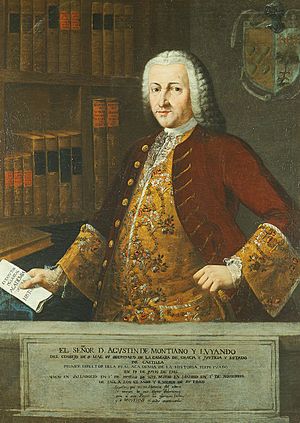Agustín de Montiano y Luyando facts for kids
Quick facts for kids
The Most Excellent
Agustín Gabriel de Montiano
|
|
|---|---|

Portrait (1765)
|
|
| Born |
Agustín Gabriel de Montiano y Luyando
28 February 1697 Valladolid, Spain
|
| Died | 1 November 1764 (aged 67) Madrid, Spain
|
| Seat F of the Real Academia Española | |
| In office 30 October 1742 – 1 November 1764 |
|
| Preceded by | Carlos de la Reguera |
| Succeeded by | Felipe Samaniego |
Agustín Gabriel de Montiano y Luyando (born February 28, 1697 – died November 1, 1764) was an important Spanish writer and historian. He is known for his plays, which followed the style of Neoclassicism. Montiano was a member of the Royal Spanish Academy, which focuses on the Spanish language. He also founded the Real Academia de la Historia (Royal Academy of History) in 1735 and became its very first director. He held a high position in the Spanish government, working as a Secretary for justice and state matters.
Early Life and Family
Agustín de Montiano was born in Valladolid, Spain. He had a brother named Manuel de Montiano, who was a high-ranking general in the Spanish Army. Manuel is famous for defending the Florida Peninsula against attacks from the English in 1738. Florida was a Spanish territory for a long time before it was sold to the United States.
Agustín became an orphan when he was young. His uncle, Francisco de Montiano, took care of him. His uncle was a judge in the Kingdom of Aragón. Agustín studied law with a famous scholar named Blas Antonio Nasarre. Because of battles during the Spanish Succession War, Agustín and his uncle had to leave Zaragoza and return to Valladolid. Later, his uncle became a judge in Majorca.
Life and Career
While living in Majorca, Agustín and his uncle started a literary group. In 1719, Agustín wrote an opera called "La Lira de Orfeo." He also wrote a poem in 1727 called "El robo de Dina."
In 1727, Agustín and his uncle moved to Madrid. His uncle became a high-ranking official in the government. After his uncle passed away, Agustín moved to Seville.
Agustín was very good at law and spoke French and Italian. This caught the attention of José Patiño, a powerful government leader. Agustín was promoted to a secretary position, helping with important political meetings and peace talks between England and Spain.
In 1734, Agustín married María Josefa Manrique. Her father, General Field Marshal Diego Antonio Manrique, was a close friend of the Queen. In 1735, Agustín became a top secretary in the Royal Spanish Council in Madrid. On March 6, 1737, he became a member of the Royal Spanish Academy. He was then chosen as a director on April 27, 1738. In 1739, he published a book comparing the actions of the Spanish King with those of the British King.
Agustín founded the Society of History, but it faced financial problems in 1744. Luckily, King Felipe V approved its continued existence. Even though there wasn't much money due to Spain's military efforts in other countries, Agustín was appointed "Perpetual Director of the Academy" in July 1745. This meant he would lead the academy for his entire life, a very special appointment that was not repeated.
Around this time, Agustín also supported his young nephew, Eugenio de Llaguno y Amírola, who later became a well-known political and intellectual figure in Madrid.
In 1750 and 1753, Agustín published two books. These books showed how the structure of Greek tragedies was used by important writers in the 1500s.
On October 29, 1759, he was chosen as a member of the Imperial Academy of Sciences in Saint Petersburg, Russia. The president of the academy, Kiril Razumoski, invited him.
Agustín also exchanged letters with other famous writers. These included Louis Racine, the son of the important French writer Jean Racine, and Jean Fitou du Tillet, who wrote about French literature.
See also
 In Spanish: Agustín de Montiano y Luyando para niños
In Spanish: Agustín de Montiano y Luyando para niños
Images for kids


